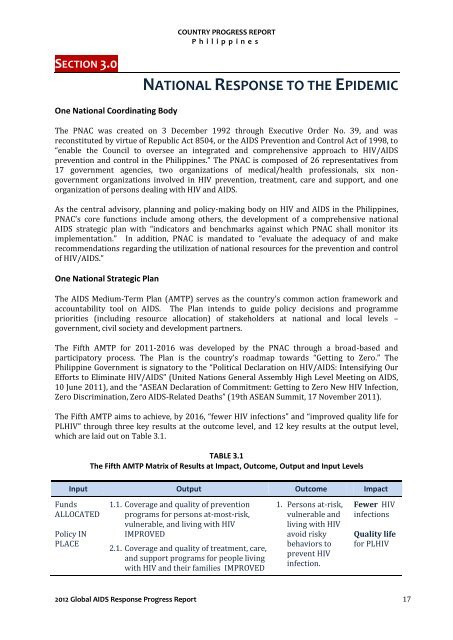Download this publication - HIV/AIDS Data Hub
Download this publication - HIV/AIDS Data Hub
Download this publication - HIV/AIDS Data Hub
Create successful ePaper yourself
Turn your PDF publications into a flip-book with our unique Google optimized e-Paper software.
COUNTRY PROGRESS REPORTP h i l i p p i n e sSECTION 3.0NATIONAL RESPONSE TO THE EPIDEMICOne National Coordinating BodyThe PNAC was created on 3 December 1992 through Executive Order No. 39, and wasreconstituted by virtue of Republic Act 8504, or the <strong>AIDS</strong> Prevention and Control Act of 1998, to“enable the Council to oversee an integrated and comprehensive approach to <strong>HIV</strong>/<strong>AIDS</strong>prevention and control in the Philippines.” The PNAC is composed of 26 representatives from17 government agencies, two organizations of medical/health professionals, six nongovernmentorganizations involved in <strong>HIV</strong> prevention, treatment, care and support, and oneorganization of persons dealing with <strong>HIV</strong> and <strong>AIDS</strong>.As the central advisory, planning and policy-making body on <strong>HIV</strong> and <strong>AIDS</strong> in the Philippines,PNAC’s core functions include among others, the development of a comprehensive national<strong>AIDS</strong> strategic plan with “indicators and benchmarks against which PNAC shall monitor itsimplementation.” In addition, PNAC is mandated to “evaluate the adequacy of and makerecommendations regarding the utilization of national resources for the prevention and controlof <strong>HIV</strong>/<strong>AIDS</strong>.”One National Strategic PlanThe <strong>AIDS</strong> Medium-Term Plan (AMTP) serves as the country’s common action framework andaccountability tool on <strong>AIDS</strong>. The Plan intends to guide policy decisions and programmepriorities (including resource allocation) of stakeholders at national and local levels –government, civil society and development partners.The Fifth AMTP for 2011-2016 was developed by the PNAC through a broad-based andparticipatory process. The Plan is the country’s roadmap towards “Getting to Zero.” ThePhilippine Government is signatory to the “Political Declaration on <strong>HIV</strong>/<strong>AIDS</strong>: Intensifying OurEfforts to Eliminate <strong>HIV</strong>/<strong>AIDS</strong>” (United Nations General Assembly High Level Meeting on <strong>AIDS</strong>,10 June 2011), and the “ASEAN Declaration of Commitment: Getting to Zero New <strong>HIV</strong> Infection,Zero Discrimination, Zero <strong>AIDS</strong>-Related Deaths” (19th ASEAN Summit, 17 November 2011).The Fifth AMTP aims to achieve, by 2016, “fewer <strong>HIV</strong> infections” and “improved quality life forPL<strong>HIV</strong>” through three key results at the outcome level, and 12 key results at the output level,which are laid out on Table 3.1.TABLE 3.1The Fifth AMTP Matrix of Results at Impact, Outcome, Output and Input LevelsInput Output Outcome ImpactFundsALLOCATEDPolicy INPLACE1.1. Coverage and quality of preventionprograms for persons at-most-risk,vulnerable, and living with <strong>HIV</strong>IMPROVED2.1. Coverage and quality of treatment, care,and support programs for people livingwith <strong>HIV</strong> and their families IMPROVED1. Persons at-risk,vulnerable andliving with <strong>HIV</strong>avoid riskybehaviors toprevent <strong>HIV</strong>infection.Fewer <strong>HIV</strong>infectionsQuality lifefor PL<strong>HIV</strong>2012 Global <strong>AIDS</strong> Response Progress Report 17















